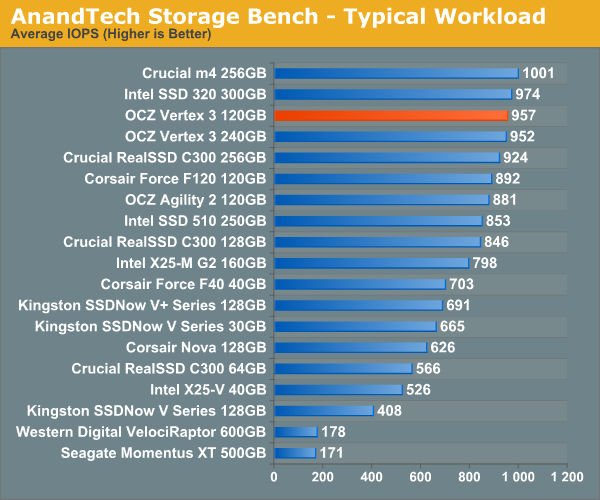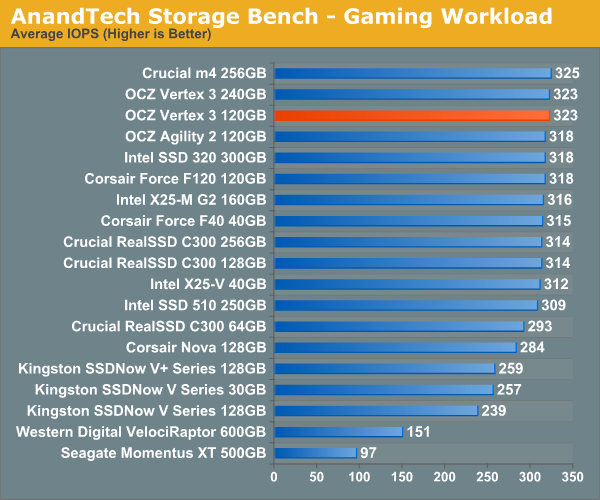The OCZ Vertex 3 Review (120GB)
by Anand Lal Shimpi on April 6, 2011 6:32 PM ESTAnandTech Storage Bench 2010
To keep things consistent we've also included our older Storage Bench. Note that the old storage test system doesn't have a SATA 6Gbps controller, so we only have one result for the 6Gbps drives.
The first in our benchmark suite is a light/typical usage case. The Windows 7 system is loaded with Firefox, Office 2007 and Adobe Reader among other applications. With Firefox we browse web pages like Facebook, AnandTech, Digg and other sites. Outlook is also running and we use it to check emails, create and send a message with a PDF attachment. Adobe Reader is used to view some PDFs. Excel 2007 is used to create a spreadsheet, graphs and save the document. The same goes for Word 2007. We open and step through a presentation in PowerPoint 2007 received as an email attachment before saving it to the desktop. Finally we watch a bit of a Firefly episode in Windows Media Player 11.
There’s some level of multitasking going on here but it’s not unreasonable by any means. Generally the application tasks proceed linearly, with the exception of things like web browsing which may happen in between one of the other tasks.
The recording is played back on all of our drives here today. Remember that we’re isolating disk performance, all we’re doing is playing back every single disk access that happened in that ~5 minute period of usage. The light workload is composed of 37,501 reads and 20,268 writes. Over 30% of the IOs are 4KB, 11% are 16KB, 22% are 32KB and approximately 13% are 64KB in size. Less than 30% of the operations are absolutely sequential in nature. Average queue depth is 6.09 IOs.
The performance results are reported in average I/O Operations per Second (IOPS):

If there’s a light usage case there’s bound to be a heavy one. In this test we have Microsoft Security Essentials running in the background with real time virus scanning enabled. We also perform a quick scan in the middle of the test. Firefox, Outlook, Excel, Word and Powerpoint are all used the same as they were in the light test. We add Photoshop CS4 to the mix, opening a bunch of 12MP images, editing them, then saving them as highly compressed JPGs for web publishing. Windows 7’s picture viewer is used to view a bunch of pictures on the hard drive. We use 7-zip to create and extract .7z archives. Downloading is also prominently featured in our heavy test; we download large files from the Internet during portions of the benchmark, as well as use uTorrent to grab a couple of torrents. Some of the applications in use are installed during the benchmark, Windows updates are also installed. Towards the end of the test we launch World of Warcraft, play for a few minutes, then delete the folder. This test also takes into account all of the disk accesses that happen while the OS is booting.
The benchmark is 22 minutes long and it consists of 128,895 read operations and 72,411 write operations. Roughly 44% of all IOs were sequential. Approximately 30% of all accesses were 4KB in size, 12% were 16KB in size, 14% were 32KB and 20% were 64KB. Average queue depth was 3.59.

The gaming workload is made up of 75,206 read operations and only 4,592 write operations. Only 20% of the accesses are 4KB in size, nearly 40% are 64KB and 20% are 32KB. A whopping 69% of the IOs are sequential, meaning this is predominantly a sequential read benchmark. The average queue depth is 7.76 IOs.











153 Comments
View All Comments
sor - Thursday, April 7, 2011 - link
Oh sure, I agree that the bottom line is whether or not it still works, that's why they do the binning and have grades of product within that brand. If OCZ can use cheaper flash and the controller takes care of the increased failures, or the users never reach the failure threshold, then who cares, as long as the product works the same?I can't speak for the testing procedures within SpekTek or their tolerances, as I only worked for a facility that tested parts for Micron, and in the process generated the bad parts and did some of the binning before sending them to SpekTek. Much of the stuff that went to them failed our tests but was otherwise not physically damaged.
There's a reason why those parts are sold under the SpecTek brand at a discount, it shows that even the manufacturer doesn't trust them to be sold under the good brand after testing.
Panlion - Thursday, April 7, 2011 - link
I wonder if OCZ will produce a 7mm 2.5 inch drive. The newer notebooks from Lenovo are starting to demand that format it'll be nice if I can have some option other than Intel SSD.sleepeeg3 - Thursday, April 7, 2011 - link
Maintaining integrity while sticking out for the little guy, instead of bending over backward to write glowing articles for every vendor sponsor. That's what has made this site succeed.I wish you could also take OCZ to task on SandForce's controller strange tendency to lock up and vanish from a system, due to built in encryption. They are in complete denial that it is an issue, despite dozens of reports on their user forums.
edfcmc - Thursday, April 7, 2011 - link
Thank you Anand for this very informative and in-depth review of the OCZ issue and their latest 120gb vertex 3 product; especially since the 120gb products are within my price range and the size I am looking to purchase. On a side note, I have been reading your reviews since your review of the FIC PA-2007 many years ago and I love the evolution of this site and your dedication to keeping us consumers informed.p.s. Please consider asking asus/Nvidia to update the Nvidia driver on their ULV80 series as nothing new has been updated since I purchased the UL80vt based on this site's recommendation. Asus/Nvida seem to be a little non-responsive to us folks who have been requesting an update for quite some time.
ekerazha - Thursday, April 7, 2011 - link
Can't wait for reviews of SSDs (Intel G3, Crucial m4) with comparable size (120 GB).Chloiber - Thursday, April 7, 2011 - link
Anand:Just a quick note. In the newest SF-firmware, there is also still a bug with Hynid Flash. You can see it here, under "Open Issues":
http://www.ocztechnologyforum.de/forum/showthread....
"Under benchmarking scenarios with IOMETER 2006, 60GB drives that use Hynix32nm MLC (1024 blocks, 8KB pages) can impose long latencies"
Just FYI.
MarcHFR - Thursday, April 7, 2011 - link
Dear OCZ, Dear Anand,In the past, it was simple :
Vertex : always the same NAND
Agility : NAND could change
I know that Vertex name is a best seller for OCZ, but i think it will be simplier to back to this
strikeback03 - Friday, April 8, 2011 - link
That is what I was wondering, I thought the point of the Agility line was that they would use the good controller but possibly cheaper NAND.Adul - Thursday, April 7, 2011 - link
Why not make use of QOR codes so a shopper can just scan the code to be taken to a page with more detail information.miscellaneous - Thursday, April 7, 2011 - link
Given this particularly insidious paragraph:"OCZ will also continue to sell the regular Vertex 2. This will be the same sort of grab-bag drive that you get today. There's no guarantee of the NAND inside the drive, just that OCZ will always optimize for cost in this line."
Will these "grab-bag" drives be using the same SKU(s)/branding as the original - well reviewed - Vertex 2? If so, how is using the _old_ SKU(s) to identify the _new_ "grab-bag" drives, whilst introducing _new_ SKU(s) to help identify drives with the _old_ level of performance a satisfactory solution?